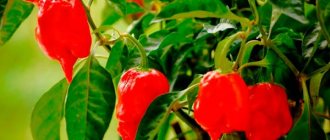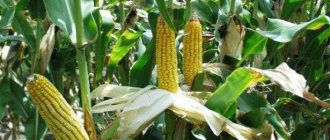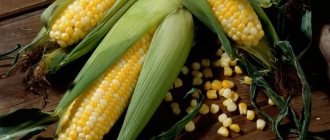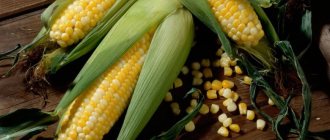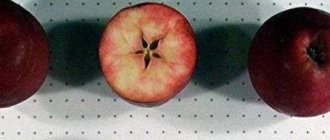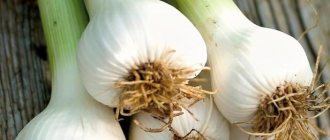Soybean - description of the culture
Common or cultivated soybean is an annual herb that is part of the botanical genus Soybean, which belongs to the Legume family. This is the only speciesA species is an evolutionarily established set of individuals, characterized by a single ... soybean, which is cultivated by humans for agricultural purposes.
The soybean plant has a straight, branching stem with many leaves. Height - up to 120 cm. The root system is classified as mixed, but some indicate it as a taproot: the main central root goes into the ground quite deeply (up to 2 m), but three-quarters of the lateral roots are located close to the surface of the earth. The root system is called mixed because the central root, going deep into the ground, has the same thickness as the lateral processes.
Soybean leaves have a trifoliate structure with leaflets of a regular diamond-oval shape. The leaves are covered with a “fluff” layer.
In the axils of the leaves, soybean forms small inflorescences-tassels, consisting of several medium-sized flowers of white or purple color. Each inflorescence can contain from 5 to 20 flowers.
From these inflorescences a small fruit-pod of a curved or straight shape eventually appears. Depending on the variety, the color ranges between ash-gray and brown. Each pod contains up to 4 seeds, and the pods themselves are pubescent, like the leaves. The seeds have a standard oval or round shape for leguminous plants with a characteristic scar.
In which regions is it better to grow and is it possible in the north?
This legume has its own preferences for territory. Yields and ease of cultivation vary by region. For a given crop, the choice of soybean variety plays a large role in choosing a region (we have provided detailed descriptions of the best soybean varieties in a separate material).
Thus, the Far East has the largest number of sown areas of this plant - more than 80%. We are talking about the Khabarovsk and Primorsky regions, as well as the Amur region. The varieties cultivated here that give a good harvest include Venus, Primorskaya and others.
The middle region is also good for soybeans. If previously soybean as a heat-loving crop was grown only in regions with a warm climate, now with the creation of early ripening varieties the situation has changed. Early and mid-ripening varieties have become suitable for cultivation in this area. Belgorodskaya, Svetla, and Luchezarnaya are just some of the names of suitable varieties.
The most early ripening and high-yielding varieties are:
- Belor;
- Okskaya;
- Mageva.
Can also be called:
- Viliya;
- Magevu;
- Yaselda.
The North Caucasus region has the most favorable conditions for plant growth and development. That is why productivity indicators there reach 45 centners per hectare.
The territory of the Urals is not the most favorable for the plant, given the arid climate of the region. As a result, the yield is also not high - a little more than 15 centners per hectare. These indicators are approximately equal to those of wheat. And given the high protein content in soybeans, growing the crop in this region seems more profitable than wheat.
You can find more information about soybean yields in various regions of the Russian Federation here.
History of soybean cultivation
Today, soybeans are grown throughout the world. The distribution area of this culture reaches 56-60 degrees northern and southern latitudes. However, this was not always the case. Just two centuries ago it was a purely local Asian culture, which few people in the West knew about.
The domestication of soybeans occurred on the territory of Ancient China, but exactly when this happened is not entirely clear. The most daring versions date this process to the sixth or seventh millennium BC. But according to more substantiated theories, the cultivation of soybeans in the Middle Kingdom did not occur earlier than the eleventh century BC.
Subsequently, soybeans were introduced from China to neighboring Korea, where they became an important agricultural crop. Then, during the period of Korean colonization of the Japanese archipelago, soybeans came to Japan. This happened between the fifth century BC and the fourth century AD.
Only several centuries later they learned about this agricultural crop in Europe. There are different opinions about which European scientist was the first to describe soybeans. Some believe that it was the German naturalist E. Kaempfer, who visited China at the very end of the 17th century. Others attribute this merit to the Russian explorer Vasily Poyarkov, who visited the banks of the Amur half a century earlier and described soybeans in his notes, which were soon published in Holland.
European botanists became seriously interested in soybeans only in the second half of the 18th century, and they began cultivating it in Europe even later - only in 1885. Americans began industrial cultivation of this crop in the late 1890s.
Due to the high yield and wide range of uses of soybeans, it has rapidly gained popularity in the West, especially in the United States. After World War II, soybeans became one of the most important crops in America, and in the rest of the world too.
At the same time, in the USSR the fate of this culture was not so rosy. Traditionally, soybean cultivation was carried out only in the Far Eastern region in the Amur River valley. Attempts to spread soybeans in southern Ukraine and the North Caucasus did not have much success in Soviet times, so the Far East has always remained the main region for soybean cultivation in our country. At the same time, our maximum harvest of up to 800 thousand tons of soybeans was in the mid-1970s, after which interest in soybeans in the USSR began to decline, and with it the area under cultivation also decreased.
The situation changed only in the early 2000s, when soybean crops stopped declining and began to increase again. Soviet indicators were quickly achieved and surpassed. Today, soybeans in Russia are grown in many regions, obtaining good results thanks to the emergence of new domestic varieties. At the end of 2016, Russian farmers harvested about 3.1 million tons of soybeans.
Economic importance of soybeans
Soybean seeds, or colloquially soybeans, are a widely sought-after product with many uses.
Due to the fact that soybeans are extremely rich in easily digestible protein, they are excellent for use in preparing a wide variety of dishes. At the same time, one of the most important niches for soy in the food market has become its use as a plant-based substitute for animal products.
For example, soybeans make a cheap but very healthy substitute for dairy and meat products. It is important to note that soy “meat” and “milk” are consumed not only by poor people who cannot afford real products, but also by those who for medical or other reasons (for example, vegans) cannot consume animal products origin.
Processing soy allows you to get a lot of other healthy and nutritious products. Thus, the following soybean products are widely used: flour (not used as classic flour, but as an additive in the preparation of complex dishes, including baking), cereals, flakes, oil (similar to sunflower), tofu (something like cheese or cottage cheese) , pasta, sauce, etc. In Japanese and Chinese cuisine, soy products are especially in demand, because soybeans have been grown in these regions for several millennia.
Soybeans are also of great importance for livestock farming. Many farmers use soy-based feed mixtures in their livestock diets.
Use of soy in cooking
What products do you choose for yourself from the wide soy range?
When I said that I had an equal attitude towards soy, I was probably lying a little, since I simply adore soy sauce. And I eat it not only with vegetable rolls. I really like to fry vegetables in ghee with spices, and then add a little of this tart aromatic liquid and lightly simmer them, season them with fresh grated ginger and enjoy. How do you like this dish? Have you tried it? Surely!
A separate song is tofu. I understand vegans who put it in all their dishes. I understand, but partly because Adyghe cheese is such a universal product for me. It, like soy, is tasteless, and also has the property of absorbing whatever comes in hand.




